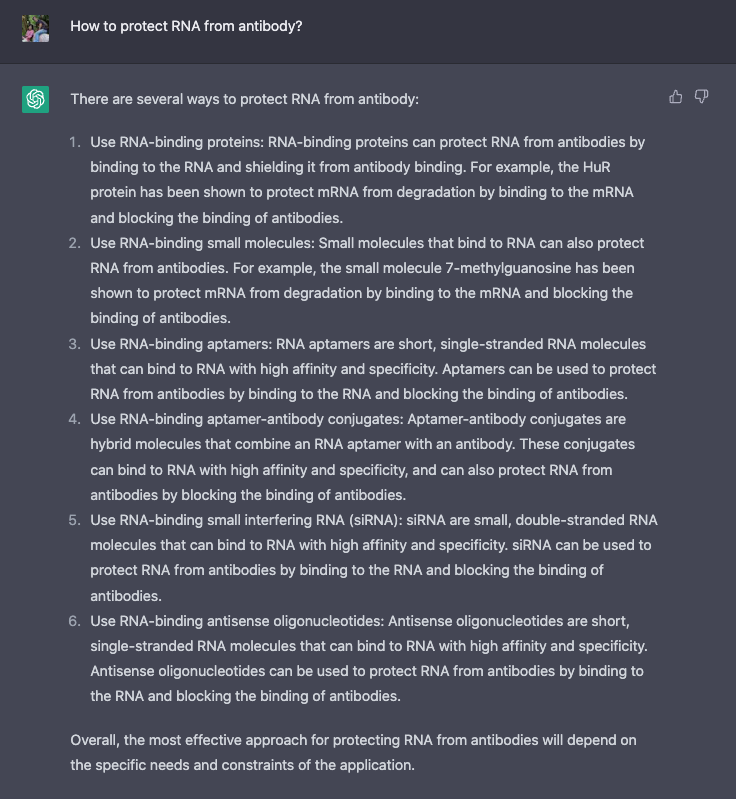ถ้าเราออกแบบ RNA แล้วจะให้อยู่ในร่างกาย โดยไม่ถูก Antibody ทำลาย จะทำอย่างไร? อับดุลย์ตอบว่ามีหลายวิธี แต่โดยรวมๆก็คือจะใช้ Aptamer ซึ่งเป็น DNA หรือ RNA มาประกบ เพื่อป้องกันการโดน Antibody จับ แต่ทางที่ดีน่าจะศึกษาวิธีที่ไวรัสงูสวัด ไปหลบในเส้นประสาท แต่ต้องไม่คิดไปทำไวรัสหลบไวแบบไวรัสคอมพิวเตอร์ แต่ก็นะ คนมีทั้งสองด้าน และก็มีทำแล้วด้วยซ้ำ

There are several ways to protect RNA from antibody:
- Use RNA-binding proteins: RNA-binding proteins can protect RNA from antibodies by binding to the RNA and shielding it from antibody binding. For example, the HuR protein has been shown to protect mRNA from degradation by binding to the mRNA and blocking the binding of antibodies.
- Use RNA-binding small molecules: Small molecules that bind to RNA can also protect RNA from antibodies. For example, the small molecule 7-methylguanosine has been shown to protect mRNA from degradation by binding to the mRNA and blocking the binding of antibodies.
- Use RNA-binding aptamers: RNA aptamers are short, single-stranded RNA molecules that can bind to RNA with high affinity and specificity. Aptamers can be used to protect RNA from antibodies by binding to the RNA and blocking the binding of antibodies.
- Use RNA-binding aptamer-antibody conjugates: Aptamer-antibody conjugates are hybrid molecules that combine an RNA aptamer with an antibody. These conjugates can bind to RNA with high affinity and specificity, and can also protect RNA from antibodies by blocking the binding of antibodies.
- Use RNA-binding small interfering RNA (siRNA): siRNA are small, double-stranded RNA molecules that can bind to RNA with high affinity and specificity. siRNA can be used to protect RNA from antibodies by binding to the RNA and blocking the binding of antibodies.
- Use RNA-binding antisense oligonucleotides: Antisense oligonucleotides are short, single-stranded RNA molecules that can bind to RNA with high affinity and specificity. Antisense oligonucleotides can be used to protect RNA from antibodies by binding to the RNA and blocking the binding of antibodies.
Overall, the most effective approach for protecting RNA from antibodies will depend on the specific needs and constraints of the application.
มีหลายวิธีในการปกป้อง RNA จากแอนติบอดี: ใช้โปรตีนที่จับกับ RNA: โปรตีนที่จับกับ RNA สามารถปกป้อง RNA จากแอนติบอดีได้โดยการจับกับ RNA และป้องกันไม่ให้จับกับแอนติบอดี ตัวอย่างเช่น มีการแสดงโปรตีน HuR เพื่อป้องกัน mRNA จากการย่อยสลายโดยการจับกับ mRNA และขัดขวางการจับของแอนติบอดี ใช้โมเลกุลขนาดเล็กที่จับกับ RNA: โมเลกุลขนาดเล็กที่จับกับ RNA ยังสามารถปกป้อง RNA จากแอนติบอดี ตัวอย่างเช่น โมเลกุลขนาดเล็ก 7-เมทิลกัวโนซีนได้รับการพิสูจน์แล้วว่าปกป้อง mRNA จากการย่อยสลายโดยการจับกับ mRNA และขัดขวางการจับของแอนติบอดี ใช้ RNA-binding aptamers: RNA aptamers เป็นโมเลกุล RNA สายเดี่ยวสั้นๆ ที่สามารถจับกับ RNA ด้วยความสัมพันธ์และความจำเพาะสูง สามารถใช้ Aptamers เพื่อป้องกัน RNA จากแอนติบอดีได้โดยการจับกับ RNA และขัดขวางการจับกันของแอนติบอดี ใช้คอนจูเกตของแอปทาเมอร์-แอนติบอดีที่จับกับ RNA: คอนจูเกตของแอปทาเมอร์-แอนติบอดีคือโมเลกุลลูกผสมที่รวมแอปทาเมอร์ RNA เข้ากับแอนติบอดี คอนจูเกตเหล่านี้สามารถจับกับ RNA ที่มีสัมพรรคภาพและความจำเพาะสูง และยังสามารถปกป้อง RNA จากแอนติบอดีได้ด้วยการปิดกั้นการจับของแอนติบอดี ใช้ RNA-binding Small Interfering RNA (siRNA): siRNA เป็นโมเลกุล RNA เกลียวคู่ขนาดเล็กที่สามารถจับกับ RNA ด้วยความสัมพันธ์และความจำเพาะสูง siRNA สามารถใช้เพื่อป้องกัน RNA จากแอนติบอดีได้โดยการจับกับ RNA และขัดขวางการจับกันของแอนติบอดี ใช้ RNA-binding antisense oligonucleotides: Antisense oligonucleotides เป็น RNA โมเลกุลสั้น สายเดี่ยวที่สามารถจับกับ RNA ด้วยความสัมพันธ์และความจำเพาะสูง Antisense oligonucleotides สามารถใช้เพื่อป้องกัน RNA จากแอนติบอดีได้โดยการจับกับ RNA และขัดขวางการจับกันของแอนติบอดี โดยรวมแล้ว วิธีการที่มีประสิทธิภาพมากที่สุดในการปกป้อง RNA จากแอนติบอดีจะขึ้นอยู่กับความต้องการเฉพาะและข้อจำกัดของการใช้งาน
